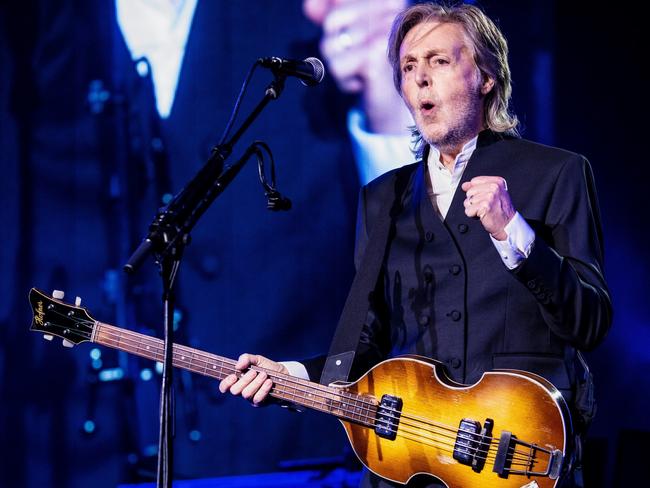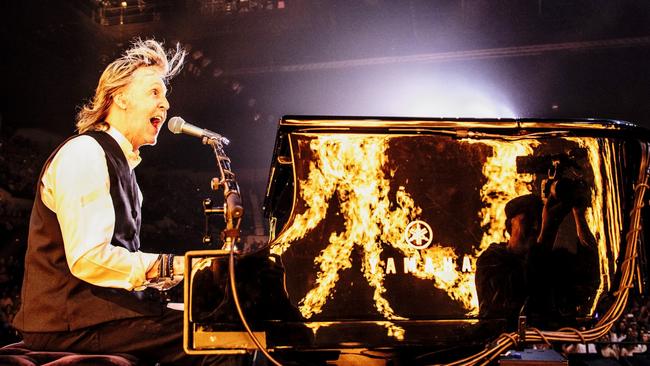McCartney has seven big stadium concerts scheduled in major cities around Australia this fortnight, including Melbourne and Brisbane and two back-to-back nights in Sydney.
Then he heads off to Mexico and Brazil, continuing his globetrotting Got Back tour with another 10 gigs.
Each time he walks on stage, McCartney will play close to 40 songs, including encores, clocking up almost three hours.
With John Lennon, McCartney used to joke how the Beatles performed sets lasting no more than 30 minutes.
The Beatles couldn’t hear themselves play much of the time because of screaming fans. They stopped touring in 1966 to get away from the madness and focus on recording. They were exhausted, too, after what had become a relentless grind.
What motivates this man now?
McCartney typically downplays his seemingly endless ambitious streak.
“It’s what I do,” he told The New Yorker’s editor David Remnick in 2021. “I plan to keep living. That’s the central idea.”

I’m with you, Paul. Yet this disarming self-description, as though he’s the ultimate existentialist, hardly fits. While McCartney clearly loves what he does, he is a man with purpose. He’s just as much the perfectionist he always was.
When Lennon came out of early retirement in 1980 to release what would be his last album, shortly before he was tragically gunned down, he was asked during a Playboy magazine interview about the possibility of a Beatles reunion.
Lennon dismissed the idea as “an illusion”. He said the band only existed on film, on record and in people’s minds. “You cannot get back together what no longer exists,” he said.
As illusions go, this one now seems very real. The Beatles never really broke up even if they parted ways in 1969 and cannot record any new music together.
Brand Beatles is an enduring powerhouse of creativity, and a thriving business. McCartney maintains his emotional connection with Lennon through the music they made together. He maintains their broader commercial relationship as Beatles for royalties and franchise income with Lennon’s estate, through Yoko Ono, and where it’s shared, with George Harrison’s estate, and Ringo Starr.
More than anything, however, after steering the group during their latter days in the studio together, McCartney has become the one-man embodiment of the Beatles.
He plays crowd-pleasers from his solo catalogue and post-Beatles group Wings, but he knows the fans see him first and foremost as a Beatle. If his mission is not personal immortality, it looks to have become a quest for something close with the Beatles.
McCartney is the Beatles’ best shot at confirming their place in the public consciousness as a major force in popular culture a century and more from now.
If the requirement for a legacy in this short-attention-span world is to persuade more generations to watch and listen, then McCartney is doing his best – and it happily coincides with his love of performing. The Beatles’ generational transfer is already well under way, as audiences range from baby boomers to Gen Z.
On stage, McCartney’s distinctive voice is much the same. He can recreate the sound with his top-notch band, close enough to the real thing.
Music journalist Paul Du Noyer wrote in his 2015 book Conversations with McCartney: “With his still-trim physique, his physical perkiness and the violin-bass guitar, he can give the masses what they crave – a living glimpse of Beatle Paul. It’s show business, and McCartney has never denied he was in show business.”
But in the end, it will be the quality of the music that counts.
Over the years, McCartney has publicly, graciously, praised some of the songwriters he admires most, from Paul Simon to Sting.
Yet as Simon told Mojo magazine in 2011, when asked to rank the greatest songwriters of all time, and returning the McCartney compliment: “It’s about whose songs last.”
Deep down, McCartney probably knows he will not be remembered individually like a George Gershwin or Duke Ellington: he will always be attached to Lennon as half of a songwriting team.
Some purists have scoffed at comparisons between the Beatles and the greats of classical music, especially as McCartney and Lennon were not classically trained or taught to sight-read.
Andre Previn, the renowned late classical conductor and composer, was no such snob. He got his start in jazz and movie scores and understood what it was all about, much like McCartney does, whether it was writing for his violinist wife Anne-Sophie Mutter or cellist Yo-Yo Ma.
In an interview for Gramophone, Previn said: “Whenever I’ve written a piece, for Anne-Sophie, or Yo-Yo, or whomever, once we’ve agreed on what it’s going to be, they all say (whispering), ‘Write me a good tune, I want to hear a big tune’. They don’t dare say it out loud – well, she does.”
Another Previn vignette sums up McCartney’s attitude as well: “I don’t tend to take myself all that seriously.”
McCartney wrote almost 200 songs with the Beatles, credited jointly with Lennon under an early agreement between the pair, regardless of whether they wrote together or alone.
All up, McCartney has written more than 1000 songs. The music is joyous, uplifting.
The clue to how McCartney perceives his legacy these days is his concert set list. He mixes it up a bit and doesn’t necessarily play what you might think is obvious – but the proportion of songs chosen from his career phases is instructive.
The average setlist for McCartney’s current Got Back tour is 62 per cent Beatles. The rest is 19 per cent McCartney and Wings, 16 per cent post-Wings solo and just under 3 per cent pre-Wings solo – which is one almost Beatles song, Maybe I’m Amazed, from 1970.
The weighty Beatles component is more than McCartney showing off his contribution to the Fab Four’s output. Since the early 2000s at least, he has been integrating John and George into his act, and sometimes Ringo.
Most obvious is McCartney’s rendition of Something, written and sung by Harrison with the Beatles, who all recognised it at the time as the standout song from the group’s last recorded studio album, Abbey Road.
‘Deep down, McCartney probably knows he will not be remembered individually like a George Gershwin or Duke Ellington: he will always be attached to Lennon as half of a songwriting team.’
Something was Harrison’s first and only A-side single with the Beatles, just as they were falling apart as a band. The song elevated Harrison to the Lennon-McCartney songwriting masterclass.
McCartney performed Something at Concert for George, a tribute event organised by Eric Clapton at London’s Royal Albert Hall in November 2002, shortly after Harrison’s death.
He began singing it solo, strumming a ukulele, before switching to guitar when the whole Clapton-arranged extravaganza joined in.
Ever since, McCartney has made a feature of performing Something as his George-Beatle tribute, starting solo on ukulele before bringing in his band. He will play it that way throughout his Australian tour.
Another significant inclusion is McCartney’s rendition of the Beatles’ I’ve Got a Feeling. The song was originally performed live during the Beatles’ surprise final concert on the roof of their London Savile Row headquarters in January 1969, and later released on the Let It Be album.
McCartney has been playing I’ve Got a Feeling for some time with his current band, with which he has been performing for two decades – double the time the Beatles were together.
The song is a rocker that showcases McCartney’s voice at its Little Richard, shouty best. Lennon provided the middle “Everybody had a hard year” lines.
Thanks to the work of film director Peter Jackson, this Paul tribute to his songwriting partner has now transformed into a remarkable “video duet” on stage.
When Jackson recently made an acclaimed three-part TV documentary based on restoring and re-editing 56 hours of film footage from the Let It Be recording sessions, he was able to isolate Lennon’s rooftop vocals on I’ve Got a Feeling so that McCartney could actually play with John singing at the same time, visible on a screen behind him.
The effect is surreal, but it works. The duet is the lead encore song on McCartney’s Got Back tour.
All up, McCartney sings 21 songs in his 37 set-list total which are jointly credited with Lennon from their Beatle days.
Two others take the Beatles’ total on the current tour to 23: Harrison’s Something and In Spite of All the Danger – which is not strictly Beatles but harks back to 1958 when they were the Quarrymen.

McCartney speaks directly to Lennon on stage when he performs Here Today, a wistful ballad. Released two years after Lennon was murdered, and shortly after McCartney’s Wings band broke up, the song comes from McCartney’s 1982 solo album Tug of War. It is based on an imaginary conversation McCartney might have had with Lennon if his friend were here today.
Perhaps the most unusual Beatles inclusion in McCartney’s set list is Being for the Benefit of Mr Kite!, a musical oddity inspired by a circus poster from the band’s 1967 Sgt Pepper’s Lonely Heart Club Band album. Lennon was the main singer when the song was released, usually a sign of who wrote what, but now it’s McCartney taking the lead alone.
In recent years McCartney has dropped the Beatles’ classic Yesterday from his onstage solo acoustic guitar interlude, possibly because his voice strains on the higher notes. But who knows? He could play it.
As a youngster growing up in suburban Sydney, I remember hearing McCartney on the radio sing the Beatles’ When I’m Sixty-Four. McCartney was 24 when this whimsical track was released on the Sgt Pepper’s album.
He doesn’t include it in his concert repertoire. But I will be there with my family and more than 53,000 other fans at Melbourne’s Marvel Stadium to witness the magic on Saturday, my birthday, when I’m 64.



Maybe I’m amazed. A musically gifted 81-year-old Brit from Liverpool, who achieved fame and wealth beyond his dreams, as he would readily admit, keeps going. And not just going. Paul McCartney has immense drive and energy for a man who doesn’t need to prove anything to anybody.